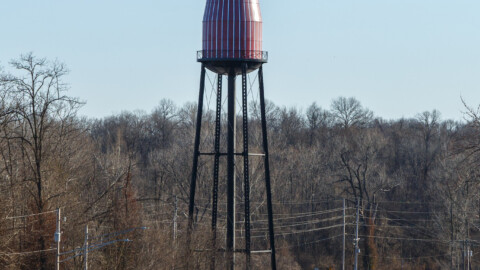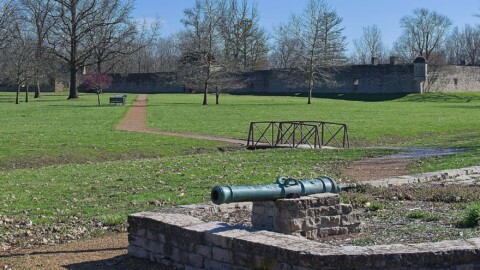
photo by Isaac Richardson
Fort Belle Fontaine, the first U.S. Military fort west of the Mississippi, harbored Lewis and Clark upon return from their westward exploration in 1806. Though the stone structures appear very old, they are not a part of the original Fort. The walls and stairs were built as a Works Progress Administration project, and were designed for recreation, not defense. There are even tales that the grounds nearby are haunted.

photo by Jason Gray

photo by Joe Harrison

photo by Isaac Richardson

photo by Isaac Richardson
For a moment, imagine yourself transported in time. The year is 1804, and it is a cold day in mid-May. You are voyaging with the Corps of Discovery into the newly accessioned Louisiana Territory, and your team is looking for a position to camp for the first night of the expedition. Through the mist, you spot a limestone overhang nearby the mouth of a tributary to the Missouri River that you are traversing upon. Your team disembarks here. Two years later, on the final night of your return voyage, you return to this location at the mouth of Cold Water Creek, to overnight again, and see that a military Fort has risen nearby in the time that you’ve been gone. This is Fort Belle Fontaine, the very first United States military installation west of the Mississippi River.
Incidentally, “Belle Fontaine” was the name given to a small natural spring that is located close to where Lewis and Clark stayed that first night, but is only visible during low water levels.

photo by Isaac Richardson

photo by Jason Gray

photo by Joe Harrison

photo by Jason Gray
Unfortunately, though the original site of the Fort (and that of the first stop of the Corps of Discovery) have massive historical significance, it exited on the flood plain of the Missouri River, and by 1810 needed to be relocated to the bluff, looming just overhead. Even more unfortunate, this second Fort was usurped in 1928 by Jefferson Barracks, just south of Carondelet, and what was left of Fort Belle Fontaine, made of wood with a stone foundation, was left to rot (there is some speculation that a small, existing stone building was built using materials from the second incarnation of the Fort, but I haven’t been able to locate any empirical evidence of this).
Despite such a short lifespan, Fort Belle Fontaine was origin or location for several important events. First, early on, the Fort was used as an “Indian Factory” or a place where Native Americans could trade furs, foodstuffs and other items for Western cloth, weapons, etc. No doubt, this was a major artery feeding St. Louis‘ mercantile ascendency. In previous Floods, like Baden, the impact of Fort Belle Fontaine has likewise been outlined.
The Fort also provided staging for military campaigns (and defense for St. Louis) in the War of 1812, and soldiers from Belle Fontaine even provided security for the Indian Council at Portage des Sioux in 1815.

photo by Jason Gray

photo by Isaac Richardson

photo by Jason Gray
In 1913, the City of St. Louis acquired the grounds of the former Fort Belle Fontaine, and constructed a complex of buildings as a training center for troubled youth. Later, as part of the Works Progress Administration, the land below the bluff was converted into a popular summer resort, complete with a beautiful grand staircase (still the Park’s major attraction), that descended visitors from atop the bluffs. The resort even warranted a stop by First Lady Eleanor Roosevelt in 1936.
Today, most of the structures from the resort that remain exist as ruins, including a bathhouse complex that looked like some ancient remnant in the mist and fog of our visit.

photo by Jason Gray

photo by Isaac Richardson

photo by Joe Harrison

photo by Joe Harrison
Today, the Park is managed by the St. Louis County Parks system, which does an excellent job of providing interpretation and conservation for the ground’s natural areas. The Park’s total area is just over 300 acres, and includes the 3 mile long Fort Bellefontaine Trail, a great introduction to both the history and ecology of the site. A residence facility for at-risk youth is still in operation, and likely the reason for the security checkpoint upon entering the Park.
If you haven’t been yet, we highly recommend a stop. The grand staircase is an absolute must-do for photography!

photo by Joe Harrison

photo by Isaac Richardson

photo by Jason Gray

photo by Jason Gray







